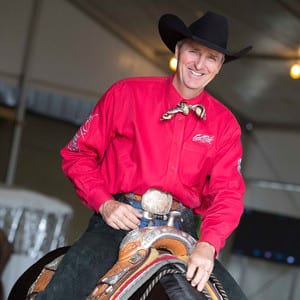Horses at the top of their game in the western pleasure pen normally all share some pretty desirable qualities. Most of them have an amazing reach at the lope, a slow pleasurable jog, and effortless body carriage.
And while some horses are just naturally more talented movers than others, there is one thing a rider can do to improve their own game in western pleasure: learn how to have flawless transitions.
Riders that know how to show a horse through both upward and downward transitions have an advantage over other riders because it means they have the ability to showcase a horse’s natural movement without interruption.
GoHorseShow sat down with the NSBA’s first million dollar rider, Gil Galyean, who has enjoyed success in the western pleasure pen Including multiple AQHA World and Congress Champion titles.
He shared some insight on what a flawless transition looks like, common mistakes, what to do when the judge is looking, and how to practice at home so your transitions are seamless come show time.
The Elements of a Flawless Transition
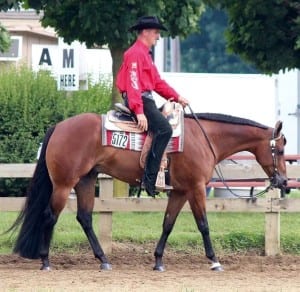 Most people (even non horse people) could distinguish a good transition from a bad transition if they saw them side by side. Common terminology used to describe a good transition is that it looks “seamless” or “smooth.” Bad transitions are commonly described as “choppy” or well, “ugly.”
Most people (even non horse people) could distinguish a good transition from a bad transition if they saw them side by side. Common terminology used to describe a good transition is that it looks “seamless” or “smooth.” Bad transitions are commonly described as “choppy” or well, “ugly.”
But what exactly does it mean to have a “smooth transition?”
“When it comes to transitions, you don’t want the forward momentum to stop,” said Galyean, “you don’t want a horse to lock up on you and half stop before changing into the next gait.”
If you think about driving a manual transmission car, if you don’t change gears correctly the car will kind of jerk stop and then go again. This is the motion Galyean says you want to avoid when changing gaits.
“The horse should not change the pace of the previous gate when they depart into the next gate,” he said.
As an example, if you are traveling at a walk and ask your horse to pick up the jog, your walk should neither quicken nor slow down before taking off.
“Horses with good transitions also don’t have a lot of change in their top line or body carriage,” Galyean said.
In other words, they stay collected.
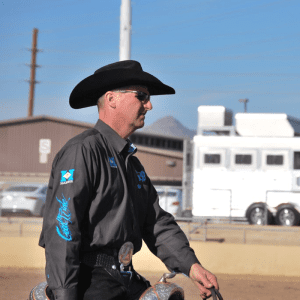 Galyean used the example of a collected horse versus an uncollected one performing a downward transition from the lope to the jog.
Galyean used the example of a collected horse versus an uncollected one performing a downward transition from the lope to the jog.
“The horse that isn’t collected will just fall immediately down to a jog,” he said.
This actually results in the horse remaining uncollected at the jog as well.
He continued, “the horse that is collected at the lope will take a couple strides more to set themselves up to break down to a jog and consequently, their jog is also much better.”
Galyean also pointed out that with downward transitions you don’t want to spend much time trying to achieve the speed you are aiming for. For example, if you are traveling at a lope and break to the jog, your jog should be that slow pleasurable speed pretty much immediately.
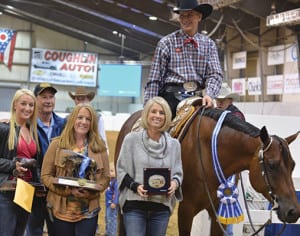 When you hear someone talk about a smooth transition, they are undoubtedly referring to what Galyean is speaking about. The goal is for your horse to maintain an even cadence before, during, and after the transition.
When you hear someone talk about a smooth transition, they are undoubtedly referring to what Galyean is speaking about. The goal is for your horse to maintain an even cadence before, during, and after the transition.
This is why watching a horse and rider with good transitions is so appealing. And why riders who can accomplish this generally will place higher on the judge’s card.
Lastly, Galyean said your horse needs to know (and be responsive!) to your transition cues.
“I like my horses to assume the shape they need to have to transition with my cue,” he said, “they respond to my cue by moving their hip over slightly to the inside and moving their shoulders slightly to the rail.”
Common Mistakes and What to do When the Judge is Looking
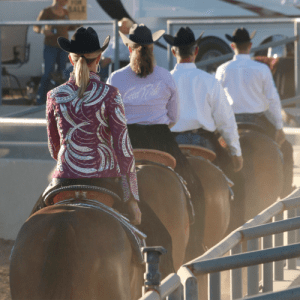 According to Galyean, there are two common mistakes riders make when performing transitions.
According to Galyean, there are two common mistakes riders make when performing transitions.
“With novice riders, you see a lot of set up and hand movement,” he said.
This includes riders that lift their hands up to ask for their horse’s face, riders who push their horse’s hip visibly to the inside, change in the horse’s pace, etc.
“You will also see them rushing the steps of the transition,” said Galyean, “meaning that they lack the feel necessary to feel the horse move their hip and shoulder over so they may do something like lope off too straight. There is timing involved with a good transition and sometimes riders miss that timing because they are in too big a hurry.”
However, as we all know, there have been times when western pleasure exhibitors have been criticized for taking too long to transition. According to Galyean, there is a happy medium.
“In my opinion, a slight hesitation to give the horse the cue and allow them to assume their shape is fine,” he said.
So how long is too long to wait?
“If a horse passes you going at the next gait, you’ve waited too long,” he said, “this undoubtedly shows your horse unfavorably to the judge.”
And for the riders (like me!) that sometimes have a slight panic attack when a transition is called for and the judge is looking RIGHT AT YOU?
Galyean says if you have good transitions this is actually the rider’s “opportunity to present their horse’s movement in the best possible way.”
“(If a judge is looking at you,) that’s your opportunity to score points,” said Galyean, “don’t wait. Go. Show what your horse can do.”
Practice Always Makes Perfect
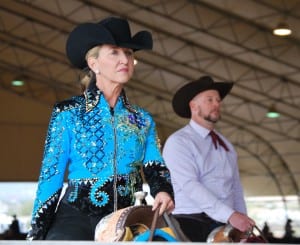 Just like anything else we practice to prepare for a show, it’s undeniably a good idea to practice your transitions at home.
Just like anything else we practice to prepare for a show, it’s undeniably a good idea to practice your transitions at home.
The main thing Galyean said was: “If you’re going to practice transitions at home, avoid going for long periods of time before stopping.”
In other words, actually practice your transitions!
“Once you trot or lope off, stop, back up, turn around, sidepass, do something!” Galyean said.
This gets the horse paying attention to your transition cues and applies for both upward and downward transitions.

“If you ask for (an upward) transition and the horse doesn’t want to take off, stop, back up or sidepass, and then ask again.”
One thing Galyean also emphasized was that: “I like my horses to wait on my voice command before going into the next gait.”
Of course, your voice and body must work together for a proper cue, but for Galyean he likes his voice to be the final word (no pun intended).
And while the focus here has been transitions in western pleasure, there is no doubt that having good transitions is important in all riding classes.
It separates the best from the rest and is something we should all strive to improve on so our ride is seamless, flawless, and a pleasure to watch!


